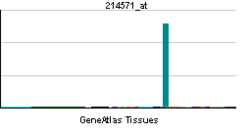FGF3
| View/Edit Human | View/Edit Mouse |
INT-2 proto-oncogene protein also known as FGF-3 is a protein that in humans is encoded by the FGF3 gene.[3]
Function
FGF-3 is a member of the fibroblast growth factor family. FGF3 binds to Fibroblast Growth Factor Receptor 3 (FGFR3) to serve as a negative regulator of bone growth during ossification. Effectively, FGF-3 inhibits proliferation of chondrocytes within growth plate.
FGF family members possess broad mitogenic and cell survival activities and are involved in a variety of biological processes including embryonic development, cell growth, morphogenesis, tissue repair, tumor growth and invasion.[3]
Clinical significance
The FGF3 gene was identified by its similarity with mouse fgf3/int-2, a proto-oncogene activated in virally induced mammary tumors in the mouse. Frequent amplification of this gene has been found in human tumors, which may be important for neoplastic transformation and tumor progression. Studies of the similar genes in mouse and chicken suggested the role in inner ear formation.[3] Also, haploinsufficiency in the FGF3 gene is thought to cause otodental syndrome.
Interactions
FGF3 (gene) has been shown to interact with EBNA1BP2.[4]
References
- ↑ "Human PubMed Reference:".
- ↑ "Mouse PubMed Reference:".
- 1 2 3 "Entrez Gene: FGF3 fibroblast growth factor 3 (murine mammary tumor virus integration site (v-int-2) oncogene homolog)".
- ↑ Reimers K, Antoine M, Zapatka M, Blecken V, Dickson C, Kiefer P (Aug 2001). "NoBP, a nuclear fibroblast growth factor 3 binding protein, is cell cycle regulated and promotes cell growth". Mol. Cell. Biol. 21 (15): 4996–5007. doi:10.1128/MCB.21.15.4996-5007.2001. PMC 87226
 . PMID 11438656.
. PMID 11438656.
Further reading
- Represa J, León Y, Miner C, Giraldez F (1991). "The int-2 proto-oncogene is responsible for induction of the inner ear.". Nature. 353 (6344): 561–3. doi:10.1038/353561a0. PMID 1922362.
- Brookes S, Smith R, Casey G, Dickson C, Peters G (1989). "Sequence organization of the human int-2 gene and its expression in teratocarcinoma cells.". Oncogene. 4 (4): 429–36. PMID 2470007.
- Casey G, Smith R, McGillivray D, Peters G, Dickson C (1987). "Characterization and chromosome assignment of the human homolog of int-2, a potential proto-oncogene.". Mol. Cell. Biol. 6 (2): 502–10. PMC 367539
 . PMID 3023852.
. PMID 3023852. - Mansour SL, Goddard JM, Capecchi MR (1993). "Mice homozygous for a targeted disruption of the proto-oncogene int-2 have developmental defects in the tail and inner ear.". Development. 117 (1): 13–28. PMID 8223243.
- Ornitz DM, Xu J, Colvin JS, McEwen DG, MacArthur CA, Coulier F, Gao G, Goldfarb M (1996). "Receptor specificity of the fibroblast growth factor family.". J. Biol. Chem. 271 (25): 15292–7. doi:10.1074/jbc.271.25.15292. PMID 8663044.
- Galdemard C, Yamagata H, Brison O, Lavialle C (2000). "Regulation of FGF-3 gene expression in tumorigenic and non-tumorigenic clones of a human colon carcinoma cell line.". J. Biol. Chem. 275 (23): 17364–73. doi:10.1074/jbc.M909316199. PMID 10749884.
- Reimers K, Antoine M, Zapatka M, Blecken V, Dickson C, Kiefer P (2001). "NoBP, a nuclear fibroblast growth factor 3 binding protein, is cell cycle regulated and promotes cell growth.". Mol. Cell. Biol. 21 (15): 4996–5007. doi:10.1128/MCB.21.15.4996-5007.2001. PMC 87226
 . PMID 11438656.
. PMID 11438656. - Popovici C, Conchonaud F, Birnbaum D, Roubin R (2004). "Functional phylogeny relates LET-756 to fibroblast growth factor 9.". J. Biol. Chem. 279 (38): 40146–52. doi:10.1074/jbc.M405795200. PMID 15199049.
- Antoine M, Reimers K, Wirz W, Gressner AM, Müller R, Kiefer P (2006). "Fibroblast growth factor 3, a protein with a dual subcellular fate, is interacting with human ribosomal protein S2.". Biochem. Biophys. Res. Commun. 338 (2): 1248–55. doi:10.1016/j.bbrc.2005.10.079. PMID 16263090.
- Tekin M, Hişmi BO, Fitoz S, Ozdağ H, Cengiz FB, Sirmaci A, Aslan I, Inceoğlu B, Yüksel-Konuk EB, Yilmaz ST, Yasun O, Akar N (2007). "Homozygous mutations in fibroblast growth factor 3 are associated with a new form of syndromic deafness characterized by inner ear agenesis, microtia, and microdontia.". Am. J. Hum. Genet. 80 (2): 338–44. doi:10.1086/510920. PMC 1785350
 . PMID 17236138.
. PMID 17236138. - Riley BM, Mansilla MA, Ma J, Daack-Hirsch S, Maher BS, Raffensperger LM, Russo ET, Vieira AR, Dodé C, Mohammadi M, Marazita ML, Murray JC (2007). "Impaired FGF signaling contributes to cleft lip and palate.". Proc. Natl. Acad. Sci. U.S.A. 104 (11): 4512–7. doi:10.1073/pnas.0607956104. PMC 1810508
 . PMID 17360555.
. PMID 17360555.
